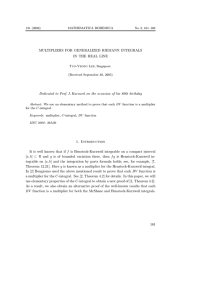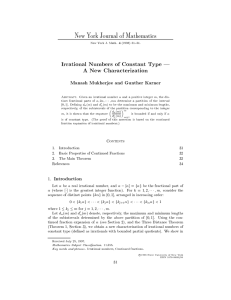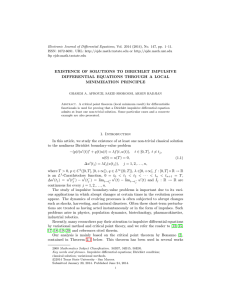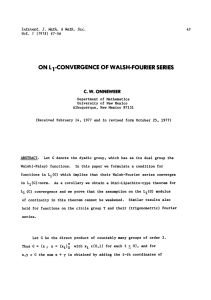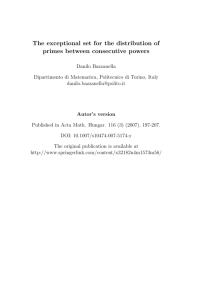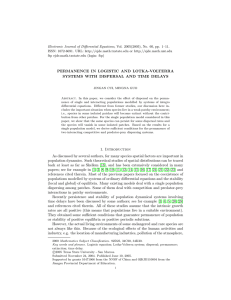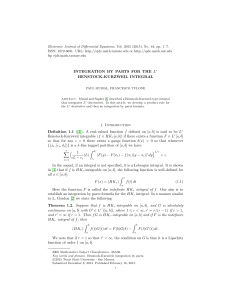A SHORT PROOF OF THE MULTIDIMENSIONAL SZEMER ´
advertisement
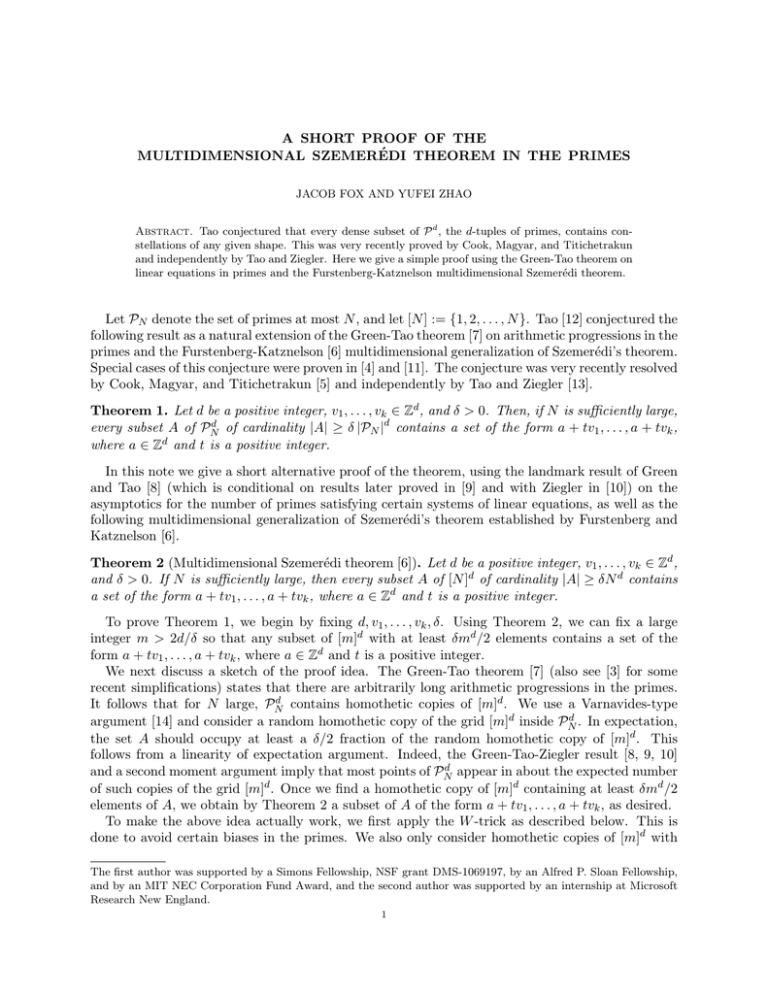
A SHORT PROOF OF THE
MULTIDIMENSIONAL SZEMERÉDI THEOREM IN THE PRIMES
JACOB FOX AND YUFEI ZHAO
Abstract. Tao conjectured that every dense subset of P d , the d-tuples of primes, contains constellations of any given shape. This was very recently proved by Cook, Magyar, and Titichetrakun
and independently by Tao and Ziegler. Here we give a simple proof using the Green-Tao theorem on
linear equations in primes and the Furstenberg-Katznelson multidimensional Szemerédi theorem.
Let PN denote the set of primes at most N , and let [N ] := {1, 2, . . . , N }. Tao [12] conjectured the
following result as a natural extension of the Green-Tao theorem [7] on arithmetic progressions in the
primes and the Furstenberg-Katznelson [6] multidimensional generalization of Szemerédi’s theorem.
Special cases of this conjecture were proven in [4] and [11]. The conjecture was very recently resolved
by Cook, Magyar, and Titichetrakun [5] and independently by Tao and Ziegler [13].
Theorem 1. Let d be a positive integer, v1 , . . . , vk ∈ Zd , and δ > 0. Then, if N is sufficiently large,
d of cardinality |A| ≥ δ |P |d contains a set of the form a + tv , . . . , a + tv ,
every subset A of PN
1
N
k
where a ∈ Zd and t is a positive integer.
In this note we give a short alternative proof of the theorem, using the landmark result of Green
and Tao [8] (which is conditional on results later proved in [9] and with Ziegler in [10]) on the
asymptotics for the number of primes satisfying certain systems of linear equations, as well as the
following multidimensional generalization of Szemerédi’s theorem established by Furstenberg and
Katznelson [6].
Theorem 2 (Multidimensional Szemerédi theorem [6]). Let d be a positive integer, v1 , . . . , vk ∈ Zd ,
and δ > 0. If N is sufficiently large, then every subset A of [N ]d of cardinality |A| ≥ δN d contains
a set of the form a + tv1 , . . . , a + tvk , where a ∈ Zd and t is a positive integer.
To prove Theorem 1, we begin by fixing d, v1 , . . . , vk , δ. Using Theorem 2, we can fix a large
integer m > 2d/δ so that any subset of [m]d with at least δmd /2 elements contains a set of the
form a + tv1 , . . . , a + tvk , where a ∈ Zd and t is a positive integer.
We next discuss a sketch of the proof idea. The Green-Tao theorem [7] (also see [3] for some
recent simplifications) states that there are arbitrarily long arithmetic progressions in the primes.
d contains homothetic copies of [m]d . We use a Varnavides-type
It follows that for N large, PN
d . In expectation,
argument [14] and consider a random homothetic copy of the grid [m]d inside PN
the set A should occupy at least a δ/2 fraction of the random homothetic copy of [m]d . This
follows from a linearity of expectation argument. Indeed, the Green-Tao-Ziegler result [8, 9, 10]
d appear in about the expected number
and a second moment argument imply that most points of PN
of such copies of the grid [m]d . Once we find a homothetic copy of [m]d containing at least δmd /2
elements of A, we obtain by Theorem 2 a subset of A of the form a + tv1 , . . . , a + tvk , as desired.
To make the above idea actually work, we first apply the W -trick as described below. This is
done to avoid certain biases in the primes. We also only consider homothetic copies of [m]d with
The first author was supported by a Simons Fellowship, NSF grant DMS-1069197, by an Alfred P. Sloan Fellowship,
and by an MIT NEC Corporation Fund Award, and the second author was supported by an internship at Microsoft
Research New England.
1
2
JACOB FOX AND YUFEI ZHAO
d are in about
common difference r ≤ N/m2 in order to guarantee that almost all elements of PN
d
the same number of such homothetic copies of [m] .
Remarks. This argument also produces a relative multidimensional Szemerédi theorem, where the
complexity of the linear forms condition on the majorizing measure depends on d, v1 , . . . , vk and δ.
It seems plausible that the dependence on δ is unnecessary; this was shown for the one-dimensional
case in [3]. Our arguments share some similarities with those of Tao and Ziegler [13], who also
use the results in [8, 9, 10]. However, the proof in [13] first establishes a relativized version of the
Furstenberg correspondence principle and then proceeds in the ergodic theoretic setting, whereas
we go directly to the multidimensional Szemerédi theorem. Cook, Magyar, and Titichetrakun [5]
take a different approach and develop a relative hypergraph removal lemma from scratch, and they
also require a linear forms condition whose complexity depend on δ.
Conditional on a certain polynomial extension of the Green-Tao-Ziegler result (c.f. the BatemanHorn conjecture [1]), one can also combine this sampling argument with the polynomial extension of
Szemerédi’s theorem by Bergelson and Leibman [2] to obtain a polynomial extension of Theorem 1.
The hypothesis that |A| ≥ δ |PN |d implies that
X
1A (n1 , . . . , nd )Λ0 (n1 ) · · · Λ0 (nd ) ≥ (δ − o(1))N d ,
(1)
n1 ,...,nd ∈[N ]
where 1A is the indicator function of A, and o(1) denotes some quantity that goes to zero as N → ∞,
and Λ0 (p) = log p for prime p and Λ0 (n) = 0 for nonprime n.
Next we apply the W -trick [8, §5]. Fix
Q some slowly growing function w = w(N ); the choice
w := log log log N will do. Define W := p≤w p to be the product of all primes at most w. For
each b ∈ [W ] with gcd(b, W ) = 1, define
φ(W ) 0
Λ (W n + b)
W
where φ(W ) = #{b ∈ [W ] : gcd(b, W ) = 1} is the Euler totient function. Also define
Λ0b,W (n) :=
1Ab1 ,...,bd ,W (n1 , . . . , nd ) := 1A (W n1 + b1 , . . . , W nd + bd ).
By (1) and the pigeonhole principle, we can choose b1 , . . . , bd ∈ [W ] all coprime to W so that
d
X
N
1Ab1 ,...,bd ,W (n1 , . . . , nd )Λ0b1 ,W (n)Λ0b2 ,W (n) · · · Λ0bd ,W (n) ≥ (δ − o(1))
, (2)
W
1≤n1 ,...,nd ≤N/W
We shall write
e := bN/W c ,
N
e /m2 c,
R := bN
e := 1A
A
b1 ,...,bd ,W
and
e j := Λ0
Λ
bj ,W
(all depending on N ). So (2) reads
X
e 1 , . . . , n d )Λ
e 1 (n1 )Λ
e 2 (n2 ) · · · Λ
e d (nd ) ≥ (δ − o(1))N
ed
A(n
(3)
e]
n1 ,...,nd ∈[N
The Green-Tao result [8] (along with [9, 10]) says that Λ0bj ,W acts pseudorandomly with average
value about 1 in terms of counts of linear forms. The statement below is an easy corollary of [8,
Thm. 5.1].
Theorem 3 (Pseudorandomness of the W -tricked primes). Fix a linear map Ψ = (ψ1 , . . . , ψt ) :
e, N
e ]d
Zd → Zt (in particular Ψ(0) = 0) where no two ψi , ψj are linearly dependent. Let K ⊆ [−N
be any convex body. Then, for any b1 , . . . , bt ∈ [W ] all coprime to W , we have
X Y
e d ).
Λ0bj ,W (ψj (n)) = #{n ∈ K ∩ Zd : ψj (n) > 0 ∀j} + o(N
n∈K∩Zd j∈[t]
A SHORT PROOF OF THE MULTIDIMENSIONAL SZEMERÉDI THEOREM IN THE PRIMES
3
e d ) := o(1)N
e d . Note that the error term does not depend on b1 , . . . , bt (although it does
where o(N
depend on Ψ).
The next lemma shows that A in expectation contains a considerable fraction of a random
homothetic copy of [m]d with common difference at most R = bN/m2 c in the W -tricked subgrid of
d.
PN
e satisfies (3), then
Lemma 4. If A
X
X
Y Y
e 1 + i1 r, . . . , nd + id r)
e j (nj + ir)
A(n
Λ
e]
n1 ,...,nd ∈[N
r∈[R]
i1 ,...,id ∈[m]
j∈[d] i∈[m]
e d . (4)
≥ (δmd − dmd−1 − o(1))RN
Proof of Theorem 1 (assuming Lemma 4) . By Theorem 3 we have
X
Y Y
e j (nj + ir) = (1 + o(1))RN
e d,
Λ
e ] j∈[d] i∈[m]
n1 ,...,nd ∈[N
r∈[R]
e ] and r ∈ [R] so that
So by (4), for sufficiently large N , there exists some choice of n1 , . . . , nd ∈ [N
X
e 1 + i1 r, . . . , nd + id r) ≥ 1 δmd .
A(n
2
i1 ,...,id ∈[m]
This means that a certain dilation of the grid [m]d contains at least δmd /2 elements of A, from
which it follows by the choice of m that it must contain a set of the form a + tv1 , . . . , a + tvk . Lemma 4 follows from the next lemma by summing over all choices of i1 , . . . , id ∈ [m].
e satisfies (3). Fix i1 , . . . , id ∈ [m]. Then we have
Lemma 5. Suppose A
Y Y
X
d
e
e d.
e
A(n1 + i1 r, . . . , nd + id r)
− o(1) RN
Λj (nj + ir) ≥ δ −
m
(5)
j∈[d] i∈[m]
e]
n1 ,...,nd ∈[N
r∈[R]
Proof. By a change of variables n0j = nj + ij r for each j, we write the LHS of (5) as
X
X
Y Y
e j (n0j + (i − ij )r).
e 01 , . . . , n0 )
A(n
Λ
d
n01 ,...,n0d ∈Z
r∈[R]
(6)
j∈[d] i∈[m]
e ] ∀j
n0j −ij r∈[N
Note that (6) is at least
X
X
e /m<n0 ,...,n0 ≤N
e
r∈[R] N
1
d
e 0 , . . . , n0 )
A(n
1
d
Y Y
e j (n0 + (i − ij )r).
Λ
j
(7)
j∈[d] i∈[m]
By (3) and Theorem 3 we have
X
d
e
e
e
e
ed
A(n1 , . . . , nd )Λ1 (n1 )Λ2 (n2 ) · · · Λd (nd ) ≥ δ −
− o(1) N
m
(8)
e /m<n1 ,...,nd ≤N
e
N
(the difference between the left-hand side sums of (3) and (8) consists of terms with (n1 , . . . , nd )
e ]j−1 × [N
e /m] × [N
e ]d−j , which can be upper bounded by using A
e ≤ 1,
in some box of the form [N
applying Theorem 3, and then taking the union bound over j ∈ [d]). It remains to show that
e d+1 ).
(7) − R · (LHS of (8)) = o(N
4
JACOB FOX AND YUFEI ZHAO
We have
(7) − R · (LHS of (8))
=
X
e 0 , . . . , n0 )
A(n
1
d
Y Y
j∈[d] i∈[m]
e /m<n0 ,...,n0 ≤N
e
N
1
d
r∈[R]
=
X
e j (n0 + (i − ij )r) −
Λ
j
e 0 , . . . , n0 )
A(n
1
d
e j (n0 )
Λ
j
j∈[d]
e
e /m<n0 ,...,n0 ≤N
N
1
d
e j (nj )
Λ
j∈[d]
Y
Y
X
Y
Y
r∈[R]
e j (n0 + (i − ij )r) − 1 .
Λ
j
j∈[d] i∈[m]\{ij }
e ≤ 1, the above expression can be bounded in absolute
By the Cauchy-Schwarz
inequality and 0 ≤ A
√
value by ST , where
2
X
Y
X Y
Y
e j (n0 )
e j (n0 + (i − ij )r) − 1
S=
Λ
Λ
j
j
e /m<n0 ,...,n0 ≤N
e
N
1
d
T =
X
j∈[d]
Y
r∈[R]
j∈[d] i∈[m]\{ij }
e j (n0j ).
Λ
e /m<n0 ,...,n0 ≤N
e j∈[d]
N
1
d
e d+2 ) (to see this, expand the square, apply Theorem 3, and observe
By Theorem 3 we have S = o(N
√
e d+1 ), as desired.
e d ), so that ST = o(N
the cancellations) and T = O(N
Acknowledgment.
We thank David Conlon, Ben Green, and Terry Tao for helpful comments.
References
[1] P. T. Bateman and R. A. Horn, A heuristic asymptotic formula concerning the distribution of prime numbers,
Math. Comp. 16 (1962), 363–367.
[2] V. Bergelson and A. Leibman, Polynomial extensions of van der Waerden’s and Szemerdi’s theorems, J. Amer.
Math. Soc. 9 (1996), no. 3, 725–753.
[3] D. Conlon, J. Fox, and Y. Zhao, A relative Szemerédi theorem, arXiv:1305.5440.
[4] B. Cook, A. Magyar, Constellations in Pd , Int. Math. Res. Not. IMRN 2012 (2012), no. 12, 2794–2816.
[5] B. Cook, A. Magyar, and T. Titichetrakun, A multidimensional Szemerédi theorem in the primes,
arXiv:1306.3025.
[6] H. Furstenberg and Y. Katznelson, An ergodic Szemerédi theorem for commuting transformations, J. Analyse
Math. 34 (1978), 275–291.
[7] B. Green and T. Tao, The primes contain arbitrarily long arithmetic progressions, Ann. of Math. 167 (2008),
no. 2, 481–547.
[8]
, Linear equations in primes, Ann. of Math. 171 (2010), no. 3, 1753–1850.
[9]
, The Möbius function is strongly orthogonal to nilsequences, Ann. of Math. 175 (2012), no. 2, 541–566.
[10] B. Green, T. Tao, and T. Ziegler, An inverse theorem for the Gowers U s+1 [N ]-norm, Ann. of Math. 176 (2012),
no. 2, 1231–1372.
[11] A. Magyar, and T. Titichetrakun, Corners in dense subsets of Pd , arXiv:1306.3026.
[12] T. Tao, The Gaussian primes contain arbitrarily shaped constellations, J. Anal. Math. 99 (2006), 109–176.
[13] T. Tao and T. Ziegler, A multi-dimensional Szemerédi theorem for the primes via a correspondence principle,
arXiv:1306.2886.
[14] P. Varnavides, On certain sets of positive density, J. London Math. Soc. 34 (1959), 358–360.
Department of Mathematics, MIT, Cambridge, MA 02139-4307
E-mail address: fox@math.mit.edu
Department of Mathematics, MIT, Cambridge, MA 02139-4307
E-mail address: yufeiz@math.mit.edu

